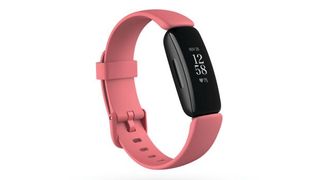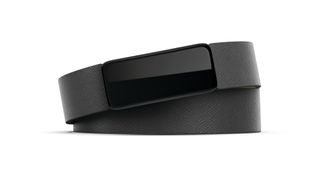Our Verdict
Although the slim, stylish design of the Fitbit Inspire 2 makes it comfortable to wear and it does a good job of basic fitness tracking, its features are limited and the small screen makes it hard to use. You can also get better value from brands like Honor, Xiaomi and Amazfit.
For
- Stylish, comfortable design
- One year of Fitbit Premium included
- Impressive battery life
Against
- Tiny screen that struggles to display much
- Awkward controls without a button
- Expensive compared to similar trackers
You can trust Coach
The original Fitbit Inspire came in two forms: Inspire and Inspire HR. The latter added a heart rate monitor for cardio analysis, sleep stage tracking and guided breathing exercises, making it well worth the extra £20.
This time, Fitbit has released one model, sensibly including a built-in heart rate sensor. The generational change is actually pretty marginal: this time around, you get Active Zone Minutes and improved battery life. That doesn’t sound like a big upgrade, but Fitbit sweetens the deal with a year’s worth of Fitbit Premium (£79.99) included.
The Fitbit Inspire 2 is likeable enough if you treat it as a basic fitness tracker and pedometer, but as soon as you try anything more advanced it becomes painfully obvious that you need to pay for something larger and more capable – one of the best fitness smartwatches or best running watches, for example. The tiny screen’s limited word counts makes notifications awkward to read and the same is true with running stats – one per screen with fiddly navigation to cycle between them while moving.
Then there’s the question of value. On paper, the Fitbit Inspire 2 doesn’t offer much more than the best cheap fitness trackers, the likes of the Amazfit Band 5, Honor Band 5 and Xiaomi Mi Band 5 which all go for less than half the price. The Inspire 2 may include that year’s worth of Fitbit Premium, but not everybody will see this as essential.
In the end, the Premium service plus the comfort, style and excellent Fitbit app, justifies the cost – but only just. If you want to be smart with your money you would spend £40 more on the Fitbit Charge 4 or £60 less for a band from Xiaomi or Honor.
Design Of The Fitbit Inspire 2
At first glance the design has barely changed: a small, plastic lozenge clipped into two rubber straps. One difference becomes apparent pretty quickly once you start using it, and it’s a change for the worse: the button from the first generation Inspire has been removed. Or, rather, inverted. You now have to pinch either side of the device to operate it, which is far less responsive, especially when you’re trying to interact with it during a run.

You can also interact with the device using the touchscreen, but this is even more fiddly. While the Fitbit Inspire 2 is 37 x 16.8mm, the actual screen part is hidden away in the middle of this, and, by my inexact measurements, is just 17 x 10mm. That’s tricky to interact with while stationary, and is even more so when running or cycling.
While the black and white OLED screen is sharp and bright, the size means it’s not great for displaying notifications. It can only show a handful of words at a time, making it a bit useless for anything other than knowing when you should reach for your phone. Even in the settings menu, you have to wait for the captions to scroll across before it’s clear what each means.
In other words, if you want a device that you regularly interact with rather than one that you can set and forget, this likely isn’t for you. But if you treat it as a smart pedometer, it’s very good: it looks stylish but understated, and it’s comfortable to wear for extended periods. With the black rubber band version we tested and a screen that’s off until woken, it’s largely invisible, although there are patterned and double wrap bands if you’d like to make more of a statement. Or, if you don’t want it on your wrist, Fitbit sells a case for it so it can be clipped on to your trousers/skirt/shorts. Obviously you won’t get the heart rate measurements this way, but it’s a welcome option.

Health Features On The Fitbit Inspire 2
Before we get to steps and activity tracking, the Fitbit Inspire 2 does have a few extra features worth highlighting. The best health feature has been a mainstay of Fitbit bands for some time, namely breathing exercises. If you decide you need a moment of calm, your Fitbit Inspire 2 can help you achieve that. Swipe down and select the Relax icon and the device will guide you through two or five minutes of breathing, where you match your inhalations and exhalations to the onscreen prompts. It’s a simple and welcome addition, where you can see genuine impact thanks to the built-in heart rate reader.
A welcome addition is that the device will display your current weight, if you’ve entered it manually into the Fitbit app or – as in my case – connect to some smart scales to automatically fill in the blanks. I’ve not seen that so prominently before and it’s genuinely useful, especially as it lists weight in stones and pounds when my scale insists on kilograms.
Other features are less valuable. There’s a window for water drunk, which would be handy except that as far as I can tell it can’t be changed on the watch itself, so to stay on top of your hydration you need to manually enter it on the app on your phone. A simple “add one glass” button, as on past Samsung fitness bands, would have been sensible.
Tracking Activity On The Fitbit Inspire 2
The main activity tracking on the Fitbit Inspire 2 is still steps, which is easily viewed by waking the device and swiping up. People get worked up about the accuracy of these things but in truth they’re all approximations, and the only important thing is that the figures are internally consistent. In other words, you just need to know whether you managed more steps than yesterday.
The big new addition is Active Zone Minutes, an innovative way of accounting for the quality of your movement, as well as the quantity. While strolling to the shops and power walking there may be the same number of steps, Fitbit will log Active Zone Minutes spent doing the latter, as detected via your raised heart rate. You have a target of 150 minutes a week – a target straight from the NHS no less – and pushing yourself into a higher heart rate zone contributes twice the minutes.
It’s hard to fault the idea or the implementation here, even if it may seem a bit too simplistic for serious fitness addicts.
Otherwise, the Fitbit Inspire 2 allows you to track running, cycling, swimming, treadmill, weights and interval workouts. The first two of these piggyback on your phone’s GPS to provide speed and distance data, while the rest track heart rate, the duration of exercise and an estimate of the calories burned.
Running With The Fitbit Inspire 2

The Inspire 2’s performance is decent but let down by the same design issues. The tiny screen means you can see only one data field at a time, and by default it’s distance travelled. You can swipe to see other fields, but the small form factor is a pain here too, requiring you to awkwardly stab at the tiny screen with one finger – tricky when going at speed. A button would have made a world of difference.
Even seeing this single data point isn’t seamless. I couldn’t get the device to wake up just by moving my wrist, no matter how sharply or purposefully I did it. Instead I had to squeeze it, which again feels unnecessarily fiddly when in motion.
There are two types of runner: those who rely on data on the fly to inform their performance, and those who trust their instincts and look at the data later. For the former, the Fitbit Inspire 2 is a tough sell, but for the latter it works pretty well. Despite lacking the on-board GPS of the best running watches, I found the data recorded on the device was only between 0.03 and 0.08km off the GPS-toting Garmin Forerunner 245 on my other wrist over short 3-4km distances, with just 3bpm difference between average and max heart rate.
That’s close enough for me, and the strength of the Fitbit app comes not just from the ease of measuring performance, but from getting inspiration or competition from your friends and colleagues. No other wearable company’s app does the latter quite as well as Fitbit.
Fitbit Premium
The Inspire 2 may cost up to three times as much as fitness trackers that offer a similar exercise experience, but it has a trick up its sleeve, and it’s a doozie: a free year’s subscription to Fitbit Premium.
Normally £7.99 a month or £79.99 a year, the service offers a whole bunch of welcome extras in three areas. These are “advanced insights” with extra sleep states and a wellness report; premium challenges and games; and guided video and audio programmes on everything from nutrition and meditation to bespoke workouts and running guides.

The guided programmes are the star of the show and they’re undeniably well done. Plus, the audio programmes are very handy for a device that, as mentioned, isn’t great at giving you live feedback on the wrist.
But it’s hard to escape the feeling that everything here is optional. The guided workouts are great, but while the content is personalised to your feedback, it’s ultimately not much better than the free videos you can find on YouTube with a little digging around. And while “advanced insights” sounds invaluable, in reality it covers things like breathing rate and heart rate variability which most people wouldn’t think are essential.
All in all, it’s a welcome addition and certainly makes the Fitbit Inspire 2 better value, but not everyone would feel the need to subscribe were it not bundled.
Sleep Tracking With The Fitbit Inspire 2
One area that benefits from these advanced insights is sleep tracking and it makes for an extremely thorough experience. While most fitness trackers have one page for each type of sleep, Fitbit divides each night into three – Time Asleep, Deep and REM, and Restoration – with each getting a graph of its own, percentage breakdowns, explanations of what everything means and tips to improve in each area.
It does offer some genuinely interesting insights. For example, on one night I found that I spent 81% of the night below my waking resting heart rate, and the remaining 19% above it. But does it actually help you sleep better? I’m not entirely convinced. While the guided meditation and sleep exercises in Fitbit Premium may help, the tips in the app are on the predictable side (don’t drink alcohol within three hours of going to sleep) and while there’s plenty of data, it still ultimately comes down to telling you whether you slept well or poorly – something most people can tell from the way they feel on a given day.
Battery Life On The Fitbit Inspire 2
One of the biggest improvements over the first generation of the Inspire comes in the form of its battery life. Fitbit promises you’ll get ten days (double that of the HR) which seems just about true, but that involves keeping the screen at a barely visible “dim” setting. Plus, the more exercise you do while connected to your phone, the more this figure will drop.
Despite this, I was quite comfortably getting seven days of use with brightness turned up. That puts the Fitbit Inspire 2 in pretty solid company as far as stamina is concerned.
Should You Buy Something Else?
Thanks to the inclusion of Fitbit Premium and the overall quality of the Fitbit app and community, I’m inclined to say that the Fitbit Inspire 2 just about justifies its £90 cost. But if any of the issues raised in this review sounds like they would grate, there are plenty of other options to consider.
On the cheaper end of the spectrum – app and Fitbit Premium aside – there’s very little to distinguish the Fitbit Inspire 2 from recent bands from Xiaomi, Honor or Amazfit and they go for around a quarter of the price. So if you’re after a basic pedometer and don’t care about community or fitness videos, they’re definitely the value option.
For people who enjoy exercising and are looking for a device to complement that passion, I’d recommend spending a bit more. The £130 Fitbit Charge 4 includes built-in GPS and a bigger screen, making it an obvious recommendation if you’re set on the fitness band look. Alternatively, the Garmin Forerunner 45 (£159.99) is a far superior beginner running watch while the Polar Unite (£134.50) is the best beginner fitness watch – and both are regularly discounted.
Alan is a freelance tech journalist and mostly covers fitness trackers for Coach.
Alan was not what you would call a big fitness guy growing up, but has been radicalised by parkrun and taken up running in a big way. Although nowhere near podium at races, as a late starter he does at least know that he can still get faster. Alan has written for ShortList, Tom’s Guide, Trusted Reviews and Expert Reviews, among others.


